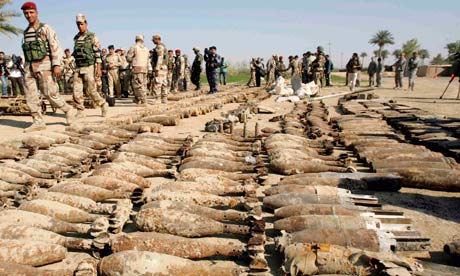 Sure enough, 15km to the south lies a big, big secret. The secret dates back to 1977, when the then-president Ahmed Hassan al-Bakr ordered the construction of a vast munitions plant outside the town. Built by the Yugoslavs, the factory was originally to be named after Bakr himself, until Saddam Hussein seized power in 1979. In a fit of patriotic zeal, the fledgling dictator named it after the Iraqi general Qa'qaa ibn Umar, who in the seventh century inflicted a most glorious massacre on the Persian army in the second battle of Qasidiya: Al Qa'qaa.
Sure enough, 15km to the south lies a big, big secret. The secret dates back to 1977, when the then-president Ahmed Hassan al-Bakr ordered the construction of a vast munitions plant outside the town. Built by the Yugoslavs, the factory was originally to be named after Bakr himself, until Saddam Hussein seized power in 1979. In a fit of patriotic zeal, the fledgling dictator named it after the Iraqi general Qa'qaa ibn Umar, who in the seventh century inflicted a most glorious massacre on the Persian army in the second battle of Qasidiya: Al Qa'qaa.
Weapons inspectors who visited the facility were dumbstruck by the scale of the place. "Huge," comments one senior figure familiar with the site. "The biggest chemical plant I've ever seen." Covering an area of 36 square km, containing 1,100 buildings and employing more than 14,000 staff, the site was essentially a secret, self-sufficient city, 10 times the size of New York's Central Park – in the middle of the desert. It even had its own power station.
Saddam was so pleased with the facility that, when the Iran–Iraq war broke out in 1980, he built a number of other weapons factories nearby. Soon, Nahir Yusifiyah, the sparsely populated crescent-shaped region surrounding the town, was teeming with facilities engaged in the manufacture of free-fall aircraft bombs, small arms, ammunition, scud-missiles, as well as nuclear centrifuge development and bio-warfare experiments: all huge, clandestine weapons sites with their own research staff and agendas.
While Caffrey, Staley and the soldiers were exploring the bunkers outside Yusifiyah, officials at the IAEA headquarters in Vienna were becoming increasingly concerned. Prior to the invasion the agency had told the Americans of the dangers of allowing the security situation to collapse. Two weeks after the start of the war, Jacques Baute, the head of the Iraq nuclear inspection teams, visited the US mission to advise, again, that the weapons sites needed protection. He specifically mentioned Qa'qaa. Just days before the invasion, he told officials, inspectors had inventoried the facility's HMX, RDX and PETN stores and ensured that the seals were still intact. This kind of materiel, the Frenchman suggested, should be kept out of the hands of looters. There was no reaction.
Privately, IAEA officials wondered whether the Americans really understood what they were doing. Qa'qaa had made the propellant for the Nasser 81 artillery rocket programme, itself at the heart of the administration's case for war. On 3 May, an internal memo at the IAEA warned that, if Qa'qaa was not secured, the result could be "the greatest explosives bonanza in history".
